Themed collection International Year of Crystallography Celebration: India

2014 International year of crystallography celebration: India
Welcome to this CrystEngComm themed issue celebrating the 2014 International Year of Crystallography in India.

CrystEngComm, 2014,16, 4665-4666
https://doi.org/10.1039/C4CE90064B
Soft-oxometalates beyond crystalline polyoxometalates: formation, structure and properties
Soft-oxometalates or soft states of oxometalates are discussed from the stand-points of their syntheses, structure, stabilization mechanism, reasons for formation and their interactions with sound and light leading to controlled motion and patterning.
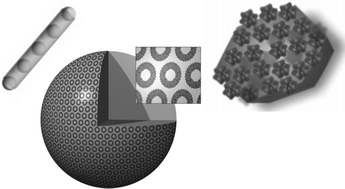
CrystEngComm, 2014,16, 4667-4676
https://doi.org/10.1039/C4CE00115J
1D, 2D and 3D coordination polymers of 1,3-phenylene diisonicotinate with Cu(I)/Cu(II): Cu2I2 building block, anion influence and guest inclusions
The reactions of a flexible bidentate ligand 1,3-phenylene diisonicotinate (L) with Cu(I/II) salts afforded coordination polymers with varied dimensionalities and guest inclusion capabilities.
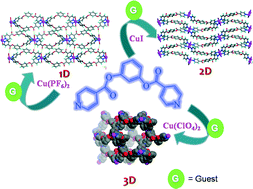
CrystEngComm, 2014,16, 4701-4705
https://doi.org/10.1039/C4CE00123K
Passive optical waveguiding tubular pharmaceutical solids and Raman spectroscopy/mapping of nano-/micro-scale defects
1D pharmaceutical solids composed of caffeine, carbamazepine and glibenclamide drugs show optical waveguiding tendency.

CrystEngComm, 2014,16, 4696-4700
https://doi.org/10.1039/C4CE00084F
Capsule voided nanospace confinement in a π-stacked supramolecular organic solid
A new C3 symmetric tripodal fluorescent organic molecule-based self-assembly-assisted supramolecular architecture has been designed and synthesised, which displayed a unique capsular cavity formed by multi-molecular aggregation.
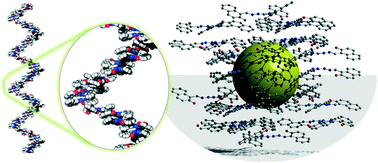
CrystEngComm, 2014,16, 4691-4695
https://doi.org/10.1039/C3CE42509F
Polymorphism and isostructurality in sulfonylhydrazones
Five new methyl and halogen derivatives of triaryl sulfonylhydrazone were synthesized to understand polymorphism and isostructurality upon Cl–Me and inter-halogen exchange. Conformational rigidity and sulfonamide dimer synthon control the isostructurality in this family of crystal structures.
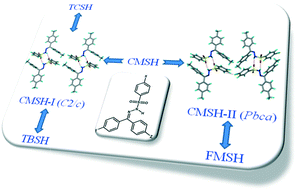
CrystEngComm, 2014,16, 4681-4690
https://doi.org/10.1039/C3CE42301H
Enhancement of CO2 uptake in iso-reticular Co based zeolitic imidazolate frameworks via metal replacement
Three Co based Zeolitic Imidazolate Frameworks (Co-ZIF-68, -69 and -81) which adopt a GME topology with high porosity have been synthesized. These Co-ZIFs show high CO2 (273 K/298 K) uptake compared to their isostructural Zn based analogues.
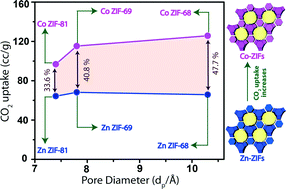
CrystEngComm, 2014,16, 4677-4680
https://doi.org/10.1039/C3CE42075B
Two 3D metal–organic frameworks of Cd(II): modulation of structures and porous properties based on linker functionalities
Two Cd(II) based 3D frameworks exhibit interesting structural features and adsorption properties based on the linker functionality modulation.
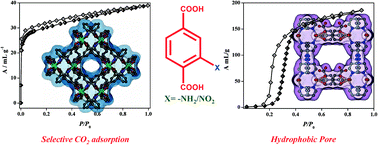
CrystEngComm, 2014,16, 4877-4885
https://doi.org/10.1039/C4CE00190G
Dual modes of binding on the hexafluorosilicate anion by a C3v symmetric flexible tripodal amide ligand in solid state
A para-nitrophenyl functionalized C3v symmetric flexible tripodal amide ligand, L, shows remarkable solvent dependent dual binding behaviour towards the octahedral hexafluorosilicate anion in solid state.
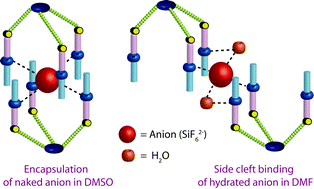
CrystEngComm, 2014,16, 4886-4891
https://doi.org/10.1039/C4CE00529E
Self-assembly patterns of steroid-based all-organic ferroelectrics: valuable insights from the single-crystals derived from an organogel and solution
We report herein the first example of a single-crystal grown from a steroid-based organogel matrix.

CrystEngComm, 2014,16, 4861-4866
https://doi.org/10.1039/C4CE00013G
The role of secondary ammonium cations in controlling the conformation of C3-symmetric acid moieties and its implication for the design of supramolecular capsules
The conformation of the carboxymethyl arms of a C3-symmetric tricarboxylic acid was found to be influenced by the acyclic substituents of the secondary ammonium cations in the corresponding salts as revealed by their single crystal structures.
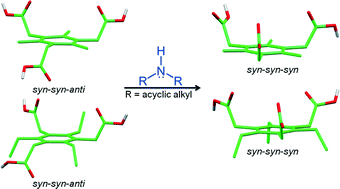
CrystEngComm, 2014,16, 4867-4876
https://doi.org/10.1039/C3CE42655F
High solubility crystalline hydrates of Na and K furosemide salts
Furosemide–Na–trihydrate displayed aqueous solubility of about 4000 fold higher than that of furosemide while furosemide–K–monohydrate has over 10 000 times improved solubility.

CrystEngComm, 2014,16, 4842-4852
https://doi.org/10.1039/C3CE42347F
Self-assembly of sterically-rigidified 3-connecting benzenetribenzoic acid into (6,3) and (3,3) nets and stabilization of water channel in the crystal lattice
A rigid 3-connecting triacid MeBTB was designed and synthesized in the quest of guest inclusion in the pores of honeycomb network structures generated based on the acid dimer-mediated self-assembly.

CrystEngComm, 2014,16, 4853-4860
https://doi.org/10.1039/C3CE42515K
Photoelectrochemical properties of CdSe quantum dots doped disk-like tripeptide capsule
CdSe quantum dots have been embedded on the disk-like matrices obtained by self-assembly of two disk-like tripeptides. Photoelectric study in ambient light demonstrates that the conductivity of the nanoconjugate has enhanced by 200 orders of magnitude compared to that of CdSe.
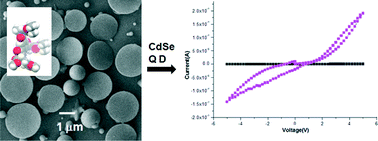
CrystEngComm, 2014,16, 4834-4841
https://doi.org/10.1039/C3CE42582G
Structural library of coordination polymers based on flexible linkers exploiting the role of linker coordination angle: synthesis, structural characterization and magnetic properties
The linker coordination angles observed in the crystal structures of a new series of coordination polymers of flexible linkers, are correlated with their dimensionality and topology.
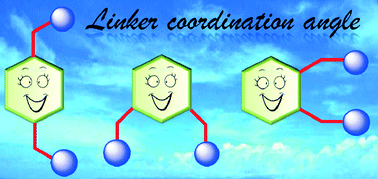
CrystEngComm, 2014,16, 4816-4833
https://doi.org/10.1039/C3CE42637H
Recognition of fluoride in fluorophenyl attached tripodal amide receptors: structural evidence of solvent capped encapsulation of anion in a C3v-symmetric tripodal cleft
A fluoride selective fluorophenyl attached triamide receptor shows encapsulation of halide in a C3v-symmetric tripodal cleft stoppered by a solvent molecule.
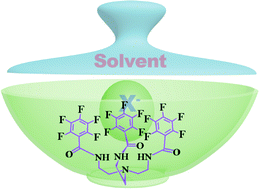
CrystEngComm, 2014,16, 4796-4804
https://doi.org/10.1039/C3CE42440E
A novel 3D 10-fold interpenetrated homochiral coordination polymer: large spontaneous polarization, dielectric loss and emission studies
A novel noncentrosymmetric 3D co-ordination polymer with a dia-net constructed under hydrothermal conditions exhibits intriguing 10-fold mutual entanglements and ferroelectric properties.

CrystEngComm, 2014,16, 4766-4773
https://doi.org/10.1039/C3CE42628A
Construction of 2D interwoven and 3D interpenetrated metal–organic frameworks of Zn(II) by varying N,N′-donor spacers
Four new MOFs of Zn(II) with different degrees of interpenetration have been synthesized using trans,trans-muconic acid and different N,N′-donors.
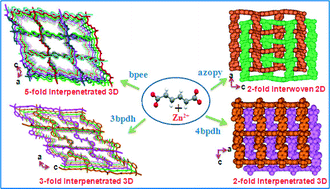
CrystEngComm, 2014,16, 4805-4815
https://doi.org/10.1039/C3CE42454E
Syntheses, X-ray structures, gas adsorption and luminescent properties of three coordination polymers of Zn(II) dicarboxylates mixed with a linear, neutral, and rigid N,N′-donor ligand
Three coordination polymers of Zn(II) were synthesized using an N,N′-donor ligand and various aliphatic dicarboxylates. The gas adsorption and photoluminescence of these compounds have also been investigated.
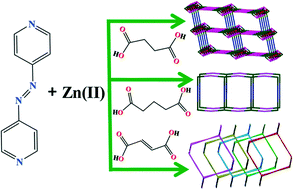
CrystEngComm, 2014,16, 4783-4795
https://doi.org/10.1039/C3CE42441C
Hydrogen bond synthon competition in the stabilization of theophylline cocrystals
In the preparation of theophylline cocrystals, phenol coformers facilitate water assimilation due to their weaker O–H⋯N(imidazole) synthon. The presence of –COOH prevents water incorporation and provides added physical stability at high humidity. This study shows the feasibility of cocrystal design of an API to tune physical properties based on hydrogen bond synthons.
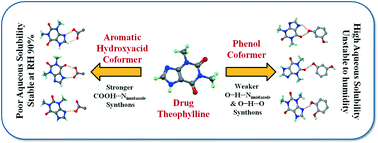
CrystEngComm, 2014,16, 4753-4765
https://doi.org/10.1039/C3CE42332H
A family of three magnetic metal organic frameworks: their synthesis, structural, magnetic and vapour adsorption study
Three flexible magnetic metal–organic frameworks (MOFs) have been synthesized and their magnetic and adsorption properties were investigated.
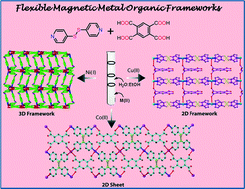
CrystEngComm, 2014,16, 4742-4752
https://doi.org/10.1039/C3CE42451K
Comparison of pyridyl and pyridyl N-oxide groups as acceptor in hydrogen bonding with carboxylic acid
The propensity of carboxyl⋯pyridyl synthon is more than carboxyl⋯pyridyl N-oxide synthon, but carboxyl⋯pyridyl N-oxide synthon forms shorter hydrogen bond than carboxyl⋯pyridyl synthon. Carboxyl⋯pyridyl N-oxide synthon containing systems might show better solubility than the corresponding carboxyl⋯pyridyl synthon containing systems.
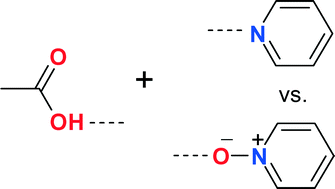
CrystEngComm, 2014,16, 4715-4721
https://doi.org/10.1039/C3CE42449A
Rare-earth carboxylates, [Ln2(III)(μ3-OH)(C4H4O5)2(C4H2O4)]·2H2O [Ln = Ce, Pr and Nd]: synthesis, structure and properties
Three new three-dimensional hybrid compounds, Ln2(μ3-OH)(C4H4O5)2(C4H2O4)]·2H2O, (Ln = Ce, Pr and Nd) (I2O1-type) exhibiting proton conductivity and multi-photon up-conversion behaviour have been described.
![Graphical abstract: Rare-earth carboxylates, [Ln2(iii)(μ3-OH)(C4H4O5)2(C4H2O4)]·2H2O [Ln = Ce, Pr and Nd]: synthesis, structure and properties](/en/Image/Get?imageInfo.ImageType=GA&imageInfo.ImageIdentifier.ManuscriptID=C3CE42311E&imageInfo.ImageIdentifier.Year=2014)
CrystEngComm, 2014,16, 4774-4782
https://doi.org/10.1039/C3CE42311E
Pharmaceutical cocrystals and a nitrate salt of voriconazole
Novel crystalline forms of voriconazole are identified with improved aqueous solubility. The dinitrate salt of voriconazole exhibited 10 fold higher solubility and 3 times faster dissolution rate in 0.1 N HCl medium compared to the reference drug.
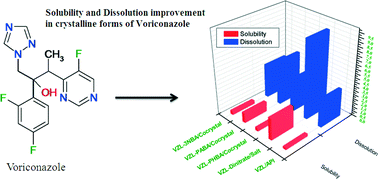
CrystEngComm, 2014,16, 4722-4731
https://doi.org/10.1039/C3CE42324G
Synthon transferability probed with IR spectroscopy: cytosine salts as models for salts of lamivudine
Co-crystal screening of the anti-HIV drug lamivudine was carried out with dicarboxylic acids as co-formers. Salts of cytosine, a molecule that incorporates critical structural features of lamivudine, with the same co-formers, were taken as model systems for IR spectroscopic studies of the synthons in the salts of lamivudine.
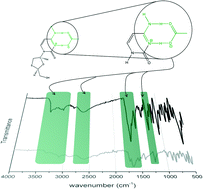
CrystEngComm, 2014,16, 4732-4741
https://doi.org/10.1039/C3CE42156B
Tautomeric preference in polymorphs and pseudopolymorphs of succinylsulfathiazole: fast evaporation screening and thermal studies
We employ a fast evaporation crystallization method to identify two new solvates from acetone and tetrahydrofuran of succinylsulfathiazole (SST), as well as determined single crystal structures for previous unsolved forms. SST adopts exclusively the imidine form in all its crystalline forms.
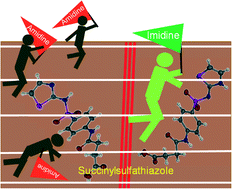
CrystEngComm, 2014,16, 4706-4714
https://doi.org/10.1039/C3CE42159G
About this collection
CrystEngComm is celebrating the 2014 International Year of Crystallography (IYCr) with a series of themed issues focusing on crystal engineering research from around the world.
Guest edited by Rahul Banerjee, the India issue highlights some of the latest research from this community.